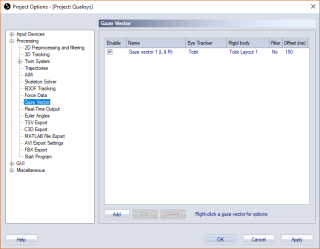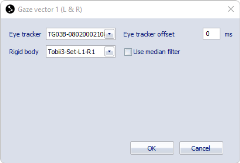Gaze vector settings
The Gaze Vector page contains a list of the current gaze vectors and the settings needed to calculate a gaze vector from the eye tracker data. Use the following options to modify the list.
-
Add
Add a new gaze vector to the list. -
Edit (or double-click on a gaze vector)
These two alternatives open the dialog below for the selected gaze vector. -
The options in the dialog defines how to calculate the Gaze vector.
-
Eye tracker
Select an eye tracker from the list. -
In Project options the list contains all of the eye trackers that are available on the Input devices page. For reprocessing with file settings, the list contains all of the eye trackers that were used in the capture.
-
Eye tracker offset
The Eye tracker offset is the number of milliseconds that the eye tracker data is delayed compared with the marker data. This value is then used as a compensation to align the data in the file. -
Rigid body
Select the rigid body that is mounted on the eye tracker. This is used as reference for the gaze vector calibration.In Project options the list contains all of the rigid bodies that are available on the Input devices page. For reprocessing with file settings the list contains all of the eye trackers that were used in the capture.
-
Use median filter
Check this option for applying a median filter for smoothing of the gaze position and gaze vector data.
-
-
Delete
Delete the selected gaze vector. -
Right-click to open menu
From the menu you can Change name of the selected gaze vector and Remove gaze vector.


